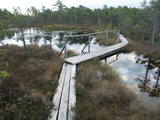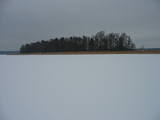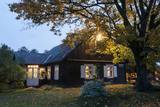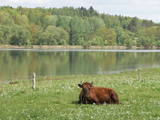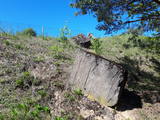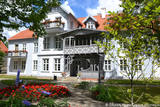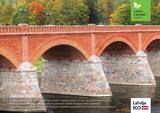| Nr | Name | Beschreibung |
|---|---|---|
|
Das Naturreservat Teiči wurde 1982 eingerichtet und ist eins der größten Hochmoore in der baltischen Region. Es besteht aus dem Teiči und dem Pelečāre Moor, mit einer Vielfalt an Pflanzen und Tieren sowie den angrenzenden Territorien, die unter Schutz stehen. Das Teiči - Moor ist das größte Nistgebiet für eine Reihe von Vogelarten einschließlich dem Kranich, dem Regenbrachvogel, dem Goldregenpfeifer und dem Strandläufer. Während des Vogelzugs gibt es hier Tausende von Gänsen verschiedener Art. Das Reservat kann nur gemeinsam mit einem Führer der Reservatsverwaltung durchquert werden. Man muß sich für so eine Tour vorher anmelden. Besucher begehen den Pfad auf Holzplankenwegen entlang dem See Silda sowie auf der Siksala Insel, wo man von einem Aussichtsturm einen phantastischen Blick auf das lettische Moorland hat.
|
||
|
Es gibt sechs Inseln im Großen Baltezers – See – die Inseln Auzu, Priežu, Mazā, Liepu, Ropažu und Meldru. Sie zeichnen sich durch eine große Pflanzenvielfalt aus, einschließlich Laubbäumen, Schwarzerlen und Kiefern. Das Territorium kann ganz gut von der Seite der lutherischen Kirche Ādaži aus betrachtet werden. Der Große Baltezers – See ist ein beliebter Ort zum Angeln, einschließlich Eisangeln während des Winters.
|
||
|
Der Hof „Jumari“ befindet sich unweit von Valpene, wo einst Krišjānis Barons seine Reise aus Terbata beendete. Der Hof besteht, umgeben von dichtem Wald, seit 1826. Das jetzige Wohnhaus wurde 1904 erbaut. Hier werden Obst und Beeren angebaut (darunter auch Kulturheidelbeeren) sowie Gemüse. Die Besucher können den Hof besichtigen, sich mit den Methoden des ökologischen Landbaus bekannt machen, Kräutertees verkosten sowie andere ländliche Leckereien probieren, den großen Garten in Augenschein nehmen, wo Obstbäume, Beerensträucher und Gemüse gedeihen. Die Wirtin des Hauses fertigt Kräuterkissen an und webt Lesezeichen. „Jumari“ ist als Sehenswürdigkeit auch in Radwege des Bezirks Dundaga einbezogen worden. |
||
|
Saaremaa, kas no igauņu valodas tulkojumā nozīmē "salu zeme" ir kā neizskaidrojams magnēts, kas ik vasaru pievelk ne tikai daudzus Latvijas, bet arī ārvalstu ceļotājus. Neparastais ar salām izraibinātais un zilais jūras klajs, savdabīgās kadiķu pļavas - alvāri, seni, neredzētas formas Dievnami, Baltijas tautām nozīmīgi vēstures pieminekļi - pilskalni, pils, nepieredzēta sugu, īpaši - putnu bagātība, vējdzirnavas, Eiropas iespaidīgākais meteorīta krāteris, senie zvejnieku ciemi ar salenieku parašām un īpatnībām - tās ir tikai dažas salas iezīmes. Salas galvaspilsēta - Kuressaare ir viena no skaistākajām Igaunijas mazpilsētām ar senu rātsnamu un rātslaukumu un vienu no iespaidīgākajām viduslaiku pilīm Baltijā, kurai pēc izskata nav līdzīgu. Kuressaare vērts pasēdēt kādā no pilsētas krodziņiem. Saaremaa salā ceļotāji tiek gaidīti vienmēr, par ko liecina labi pārdomātā un kvalitatīvā tūrisma infrastruktūra. Sala ir īsta paradīze ne tikai mierīgas atpūtas meklētājiem, bet arī visa veida aktīvās atpūtas piekritējiem - kājāmgājējiem, velobraucējiem, jūras viļņu vagotājiem un dabas vērotājiem! |
||
|
Meklējamas Lizuma ciema dienviddaļā. Tās ir vienas no retajām vējdzirnavām (1880. g.), kas saglabājušās labā stāvoklī. Mūsdienās dzirnavas ir gleznotājas Ilonas Brektes īpašums. |
||
|
Eine Insel in der Nemunas-Deltamündung. Ethnographisches Museum, Uostadvaris-Leuchtturm, Vogelbeobachtungsturm. |
||
|
Das Restaurant befindet sich in der Altstadt von Liepaja, im Zentrum der Stadt: am Rosenplatz, im Verkaufshaus Kurzeme. Lettische Küche: Gemüsesuppe, kalte Rote-Beete-Suppe, Schweinefleischscheibe, Erdbeersuppe. |
||
|
Atrodas Skolas ielā 12, Priekules pamatskolā. Tās krājumā ir plašs Priekules novadā iegūto vēsturisko liecību klāsts – sadzīves priekšmeti, darbarīki, dokumenti, padomju gados izsūtīto un represēto cilvēku atmiņu stāsti u.c. liecības, kā arī Priekules skolu attīstības vēsture. |
||
|
Atrodas Vecpiebalgas dienviddaļā pie Inešu ceļa. No sarkanajiem ķieģeļiem būvētā ēka uzcelta 1887. g. par vietējo iedzīvotāju saziedotajiem līdzekļiem. Vairāk nekā simts gadus šī ir vieta, kur vecpiebaldzēni pulcējas uz nozīmīgiem notikumiem, svētkiem, uzturot novada kultūras mantojumu. Celtni uzskata par vienu no spilgtākajiem Latvijas lauku arhitektūras pieminekļiem. Tai blakus uzstādīts piemineklis brāļiem Kaudzītēm. |
||
|
Stūrīši is a homestead owned by the Taisel family, offering a collection and a chance to taste Liv foods: fish soup, porridge, sprat sandwiches, pastries, etc. |
||
|
Der Naturpark im Tal der Daugava ist der einzige Ort zwischen den Kaskaden der Wasserkraftwerke, wo man noch die Chance hat, das Flusstal der Daugava und die Schluchten der Nebenflüsse so zu sehen, wie sie waren, bevor das Gebiet geflutet und die Kraftwerke gebaut wurden. Einen besonders schönen Blick hat man vom rechten Flussufer in der Nähe von Kirche und Burgberg von Aizkraukle. Wälder, Wiesen, Flussquellen und kleine Dolomitfelsen sind in dieser Region alles geschützte Biotope. Freizeitangebote gibt es auf dem Burgberg von Aizkraukle, die Schloßruinen von Aizkraukle sind nicht weit entfernt.
|
||
|
Nordeķu - Kalnciema kāpu grēdas daļa Kleistu meža austrumdaļā pie Dzirciema ielas. Padomju laikā šeit darbojās divi (vēlāk viens) P - 35 radars, kas griezās ap savu asi. Vietējie iedzīvotāji tolaik šo vietu bija iesaukuši par "Lokatoru kalniņu". Ziemeļos no tā atradās padomju armijas cūku ferma. |
||
|
Nicht selten wird das Schloss Šilutė nach dem letzten Besitzer auch heute noch als das Hugo-Scheu-Schloss bezeichnet. Der Gutsherr und Begründer des Schlossparks, Hugo Scheu, erwarb das Gut 1889. Er ließ die Gebäude und die Umgebung instandsetzen und 2 Parks anlegen, den Schlosspark und den Krähenwaldpark. Neben dem Schloss entstand der Schlosspark mit Spazierwegen im englischen Stil. Der Waldpark war für das Spazieren der Städter vorgesehen; er befand sich beidseitig des Flüsschens Šyša und war mit einer Fußgängerbrücke verbunden. In dem Park, der bis zur alten Eisenbahnbrücke reichte, gab es etwa 150 Pflanzenarten. Jetzt gibt es in dem Park 40 Arten Bäume und Sträucher. |
||
|
A very impressive ensemble that is in terrible shape. The estate dates back to the 18th and 19th century, with the castle being built in the early 19th century. Half a century later it was rebuilt in the Neo-Gothic style with symmetrical towers and bricks in the cornices. The estate belonged to the Manteufel-Stzege dynasty. The vestibule, stairwell and second floor hall still have ornamental ceiling paintings, but visitors are not allowed to enter the building, so they cannot be seen. Valuable interior design elements include a fireplace from the early 19th century that is decorated with marble elements. After the expropriation of the castle in 1920 and until 1951, the building housed a forestry school and then an agricultural crafts school. Opposite the castle was the stable of the state that was built in the style of Classicism with a pediment and mighty columns. Built in the early 19th century, the stable is no longer used and can only be viewed from the outside. A very much overgrown park surrounds the complex, and the hillock is the grave of one of the baron’s dogs.
|
||
|
Die ehemalige Schwimmhalle von Ķemeri
– im 19. Jahrhundert befand sich hier ein
Holzgebäude mit Wannen, aber 1924 wurde hier
ein Gebäudekomplex für heilende
Schlammprozeduren angebaut. Nach dem
Zweiten Weltkrieg wurde die Kurortpoliklinik
„Ķemeri“ eingerichtet. Heutzutage ist das unikale
Gebäudekomplex runtergekommen, obwohl es
privatisiert wurde. An der westlichen Seite
befindet sich ein Denkmal für den eminenten
russischen Arzt - Physiologen Ivan Pavlov
das von Zeit und Menschenhand nicht verschont
geblieben ist.
|
||
|
Celta 1933. g. vietējai brāļu draudzei. Baznīcā atrodas glezna “Kristus” (1850. g.) un Liepājas meistara Jēkaba Jauģieša 1920. g. darinātās ērģeles. Mūsdienās dievnamu izmanto Bārtas draudze. Pie baznīcas novietots akmens apkaimes represētajiem iedzīvotājiem. |
||
|
This craftsman uses the black ceramics technique. You can watch him opening the kiln, take part in creative workshops, and commission or purchase ceramics products. |
||
|
Die Wirtschaft Strauti befindet sich am östlichen Rand des Hügellandes von Embūte. Südlich wird die Wirtschaft von Wäldern eingeschlossen, wo viele Wildtiere wohnen, die man in Lettland treffen kann. Neben der Wirtschaft befinden sich die Gebäude der ehemaligen Geflügelfarm. Auf dem Hof werden Zuchtkaninchen, Schafe, verschiedene Geflügel, zwei Pferde und ein Pony gezüchtet. Auf den Feldern der Wirtschaft weiden Kühe, darunter kann man auch die blauen Kühe von Lettland besichtigen. Die Wirtin bietet Führungen für Schülergruppen und andere Interessenten an. Mit vorheriger Anmeldung kann man Kaninchenfleisch, Schafwolle, sowie die in der Wirtschaft angebauten Gemüse kaufen. Biowirtschaft. |
||
|
Der berümte Jakob Kettler, Herzog von Kurland regierte genau 40 Jahre (1642 – 1682). In dieser Zeit geschahen in Kurland große Veränderungen – rasch entwickelte sich den Schiffbau, erschienen erste Manufakturbetriebe und vergrößerten sich die Umfänge der Landwirtschaftsproduktion. |
||
|
Die Anlage des Parks begann zu Beginn des 19. Jahrhunderts als Landschaftspark mit vielen Spazierwegen, Bänken und Brücken. Gegenwärtig ist der Park Kazdanga der Fläche nach (196 ha) einer der größten und zudem einer der aus dendrologischer Sicht reichhaltigsten Parks in Lettland. Hier wachsen über 200 Arten Gehölze, davon 127 fremdländische. Der Park zieht sich durch das gesamte Dorf Kazdanga, einschließlich des Gutshofs, bis hin zu der Stelle wo sich nördlich davon die Krypta der Familie von Manteuffel befindet. Der Bau dieser Krypta wurde mit Beginn des 1. Weltkriegs abgebrochen. Im Park gibt es mehrere Rastplätze und viele dekorative Elemente. Das Schloss Kazdanga wurde um 1800 erbaut. Der Entwurf stammte von dem in Europa bekannten Architekten Johann Georg Berlitz, wobei er auf ein Projekt von Giacomo Quarenghi zurückgriff. Das Schlossensemble besteht außerdem aus dem Ritterhaus, dem Gesindehaus, dem Wohnhaus, Marstall, der dreibögigen Brücke, die über eine Schlucht führt, und weiteren Gebäuden. 1922 wurde hier eine Landwirtschaftsschule eröffnet. Heute gibt es hier das Schlossmuseum und unweit davon das Touristeninformationszentrum. |
||
